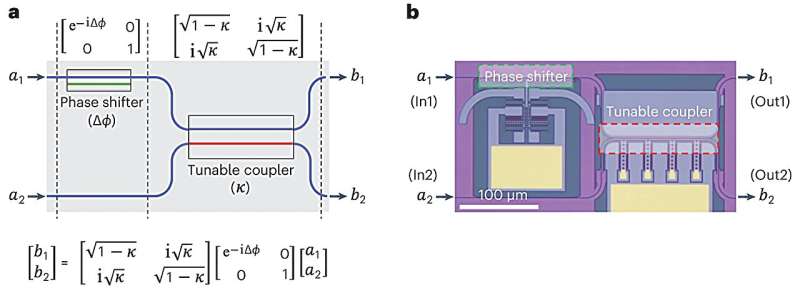This article has been reviewed according to Science X's editorial process and policies. Editors have highlighted the following attributes while ensuring the content's credibility:
fact-checked
proofread
Key innovation in photonic components could transform supercomputing technology

Programmable photonic integrated circuits (PPICs) process light waves for computation, sensing, and signaling in ways that can be programmed to suit diverse requirements. Researchers at Daegu Gyeongbuk Institute of Science and Technology (DGIST), in South Korea, with collaborators at Korea Advanced Institute of Science and Technology (KAIST), have achieved a major advance in incorporating microelectromechanical systems into PPICs.
Their research has been published in the journal Nature Photonics.
"Programmable photonic processors promise to outperform conventional supercomputers, offering faster, more efficient and massively parallel computing capabilities," says Sangyoon Han of the DGIST team. He emphasizes that, in addition to the increased speeds achieved by using light instead of electric current, the significant reduction in power consumption and size of PPICs could lead to major advances in artificial intelligence, neural networks, quantum computing, and communications.
The microelectromechanical systems (MEMS) at the heart of the new advance are tiny components that can interconvert optical, electronic, and mechanical changes to perform the variety of communication and mechanical functions needed by an integrated circuit.
The researchers believe they are the first to integrate silicon-based photonic MEMS technologies onto PPIC chips that operate with extremely low power requirements.
"Our innovation has dramatically reduced the power consumption to femtowatt levels, which is over a million times an improvement compared to the previous state of the art," says Han. The technology can also be built onto chips up to five times smaller than existing options.
One key to the dramatic reduction in power requirements was to move away from the dependence on temperature changes required by the dominant "thermo-optic" systems currently in use. The required tiny mechanical movements are powered by electrostatic forces—the attractions and repulsions between fluctuating electric charges.
The components integrated onto the team's chips can manipulate a feature of light waves called "phase" and control the coupling between different parallel waveguides, which guide and constrain the light. These are the two most fundamental requirements for building PPICs. These features interact with micromechanical "actuators" (essentially switches) to complete the programmable integrated circuit.
The key to the advance has been to apply innovative concepts to the fabrication of the required silicon-based parts. Crucially, the manufacturing process can be used with conventional silicon wafer technology. This makes it compatible with the large-scale production of photonic chips essential to commercial applications.
The team now plans to refine their technology to build and commercialize a photonic computer that will outperform conventional electronic computers in a wide variety of applications. Han says that examples of specific uses include the crucial inference tasks in artificial intelligence, advanced image processing, and high-bandwidth data transmission.
"We expect to continue to push the boundaries of computational technology, contributing further to the field of photonics and its practical applications in modern technology," Han concludes.
More information: Dong Uk Kim et al, Programmable photonic arrays based on microelectromechanical elements with femtowatt-level standby power consumption, Nature Photonics (2023). DOI: 10.1038/s41566-023-01327-5
Provided by Daegu Gyeongbuk Institute of Science and Technology (DGIST)




















